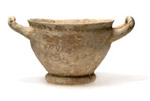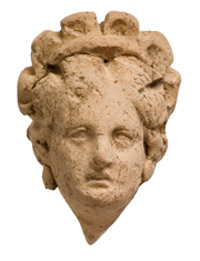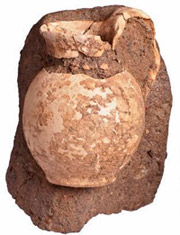

Wine cup, Necropolis 5th century tomb in Satricum
Satricum
One of the best preserved sites in Central Italy, ancient Satricum (modern Le Ferriere, province of Latina) has a long research history, starting in the nineteenth century with Italian excavations, and followed in the 1970s by Dutch excavations executed by the Dutch Institute in Rome, The University of Groningen and the University of Amsterdam. Satricum contains archaeological remains from at least the 9th century BC until the 1st century AD, including a road network, two necropoleis, a small sanctuary and a Roman villa, but the site is mainly known for the major Archaic sanctuary of Mater Matuta, goddess of dawn, on the ‘acropolis’ hill, along the river Astura. Three votive deposits indicate offering practices over a long period, and rectangular structures around the temple may be related to the sanctuary. These stone buildings are preceded by huts, small votive pits and child burials (9th-7th centuries BC). During the 5th century people were buried in the city area, and around 200 BC a small farmstead was built nearby on the Acropolis. The large chronological time-span and the diversity of find contexts and materials (from coarse hand made impasto to decorated Greek imports) make Satricum an ideal candidate for the NPAP research questions concerning ceramic production technology and organization, and perception and use of pottery of different traditions and provenances in various functional and cultural contexts over time.

Terracotta head of female statuette, Hellinistic votive depot

Jug, Necropolis 5th century tomb in Satricum